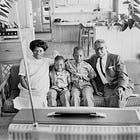
“She responded that the only harm she had experienced was that we were living on their land.”
-Jose Olivera, a Spanish Sergeant, and Jose Maria Pico, an interpreter, interviewing Toypurina, medicine woman and Shaman, 17851.
The first valley girl2 was quite far from the highly commercialized version that has been immortalized in American consciousness. She had no connection to shopping malls, middle-class income, or blonde side-ponytails. The first valley girl was Native: she lived in the long stretches between my elementary school and high school, back when they were populated by the Tongva tribe. She may not have even been female; two-spirited people were celebrated3 in Tongva culture.
She might have ventured all the way out to Topanga Canyon to hunt with her family—a canyon I routinely drove through to the beach as a teenager— or, as some historians suggest, she may have gone all the way out to Malibu to fish. But after hundreds of years, the original valley girls were enslaved.
When Spanish settlers arrived in Southern California around the 1700s and began setting up Catholic missions, it was valley girls and their families who were oppressed and exploited, forced to build and work within these communities. Classic colonialist narratives of “civilizing” the Tongva justified systemized forced baptisms, rapes, assaults, and slave labor. Native Americans who resisted Spanish rule and Catholicism were publicly flogged to be made examples of.
Among those watching was Toypurina4, a medicine woman of the Kizh Nation who spent her girlhood5 watching the first Spanish colonizers take hold of her home. In her lifetime, she was witness to the multi-pronged devastations of colonialism: disease, assimilation, suppression of culture, and land loss.
The European presence was unrelenting; between 1772 and 1785 the Spanish “Padres” had reportedly baptized about 1,200 Native people from the area around the San Gabriel Valley6. There were also fewer and fewer resources available to those who resisted colonial rule. The San Gabriel mission had assumed the land previously used for hunting by Toypurina’s community. The mission’s livestock were also damaging the ecosystem that the Tongva had long relied on for food.
By 1785, Toypurina’s village was barely able to sustain itself. There were no other options for survival but to revolt.
By separating her from other Native peoples, the Spanish also siphoned another precious resource: Native resistance to colonialism.
With her community’s legacy in mind, Toypurina coordinated a rebellion with her brother, a leader of her village, as well as Nicholás José, a “Gabrielino”7 who lived at the mission. There are different versions of her participation in the rebellion, some of which have been exoticized to include “sorcery.”8 What is uncontested is that Toypurina was very influential and widely respected for her wisdom, perhaps why she was tapped as an essential resource for this strategy.
According to historians, she went from village to village, recruiting participants from between six and eight villages in total9. The plan was simple but bold: kill the San Gabriel mission leaders, take over, and kick out the Spanish. On October 25th, 1785, Toypurina joined the villagers as they made their way. But the plan was never carried out; the mission got word of the attack beforehand and Toypurina was captured along with 21 others.
When interrogated by her captors, Toypurina is depicted as understanding the great odds against her and the other villagers (the mission had cannons, after all). She is quoted10 as stressing “bravery” above all else. She showed no remorse for her actions, insisting on the colonizers’s harm to the land.
The captured villagers endured lashings and were sent back to their homes as warnings. Meanwhile, Toypurina was deemed one of the leaders of the revolt and was put on trial, in chains, in Monterey, California (the Spanish colonial capital). After being found guilty, she was imprisoned at the San Gabriel mission—the very mission she hoped to take over— for two and a half years.
Governor Pedro Fages, worried that an execution would make Toypurina a martyr, decided a banishment would serve as her final punishment. Colonizers sent her to the farthest mission in Carmel, California, over 350 miles away from where Toypurina was raised. This banishment would effectively sever her from the community she loved for the rest of her life. By separating her from other Native peoples, the Spanish also siphoned another precious resource: Native resistance to colonialism.
She is considered the only woman to have led a rebellion against European colonizers in North America.
Toypurina’s punishment continued as she was forced to marry a Spanish soldier and convert to Catholicism. She would go on to have three children.
While often framed by colonizers as abandoning her beliefs, there is one detail that suggests otherwise: Toypurina died in 1799 at the age of 39 without confessing her sins, standard protocol from the Catholic Church11. Her reluctance to participate in this rite is interpreted by some as her last defiance in the face of the Spanish.
While little-known by broader history, Toypurina is remembered by Indigenous historians and scholars as a “Joan of Arc”-like figure12. She is considered the only woman to have led a rebellion against European colonizers in North America.
Toypurina’s efforts were exceptional but her circumstances are not. She is one of the many original women and two-spirit people of this area; a woman who was not brought here or colonized the area with her husband, but was born and raised among the hills and the ocean. She was the first one to gauge the danger of predators, to brave the heat and watch the sun.
And yet when the cultural shorthand of the Valley Girl13 is evoked, women like her are not.
Next week: the 30th anniversary of Clueless’s opening weekend.
Beebe, Rose Marie and Robert M. Senkewicz, ed. Lands of Promise and Despair: Chronicles of Early California, 1535-1846. Heyday Books, 2001.
Lowercase “valley girl” to indicate a female-identified or pangender individual who happens to be from or inhabits the San Fernando Valley.
“The Founding Folk of L.A. Were LGBTQ-Friendly, Celebrated ‘Two-Spirited’ Tribe Members.” The Pride, 10 July 2025, https://thepridela.com/2018/10/the-founding-folk-of-l-a-were-lgbtq-friendly-celebrated-two-spirited-tribe-members/. Accessed 9 July 2025.
Toypurina was raised in what is now considered San Gabriel Valley. While not a “valley girl” as designated from the San Fernando Valley, she was raised in a time when there was no such delineation between these two valleys.
Historians say Toypurina was between 9 and 11 years old when first colonizers arrived in her area.
“Life Story: Toypurina (1760–1799).” Women & the American Story, The New York Historical, wams.nyhistory.org/settler-colonialism-and-revolution/settler-colonialism/toypurina/#resource. Accessed 8 July 2025.
The baptized Tongva were known as “Gabrielinos” by colonizers.
A popularized narrative is that Toypurina was tasked with mystically immobilizing the Catholic priests while her male co-leaders ambushed. This has been contested.
“Rebel Tongva Warrior.” Gold Chains: The Hidden History of Slavery in California, The ACLU of Northern California, www.aclunc.org/sites/goldchains/explore/toypurina.html. Accessed 8 July 2025.
Toypurina’s direct quotes have been contested as being colored by her captors and misinterpreted after the fact, so I won’t be repeating them here.
Widener, Leslie Stall. Toypurina: Woman Warrior. CORE KNOWLEDGE FOUNDATION, 2023. Pg. 26.
Widener, Leslie Stall. Toypurina: Woman Warrior. CORE KNOWLEDGE FOUNDATION, 2023. Pg. 27.
Uppercase “Valley Girl” to indicate the manufactured caricature.






